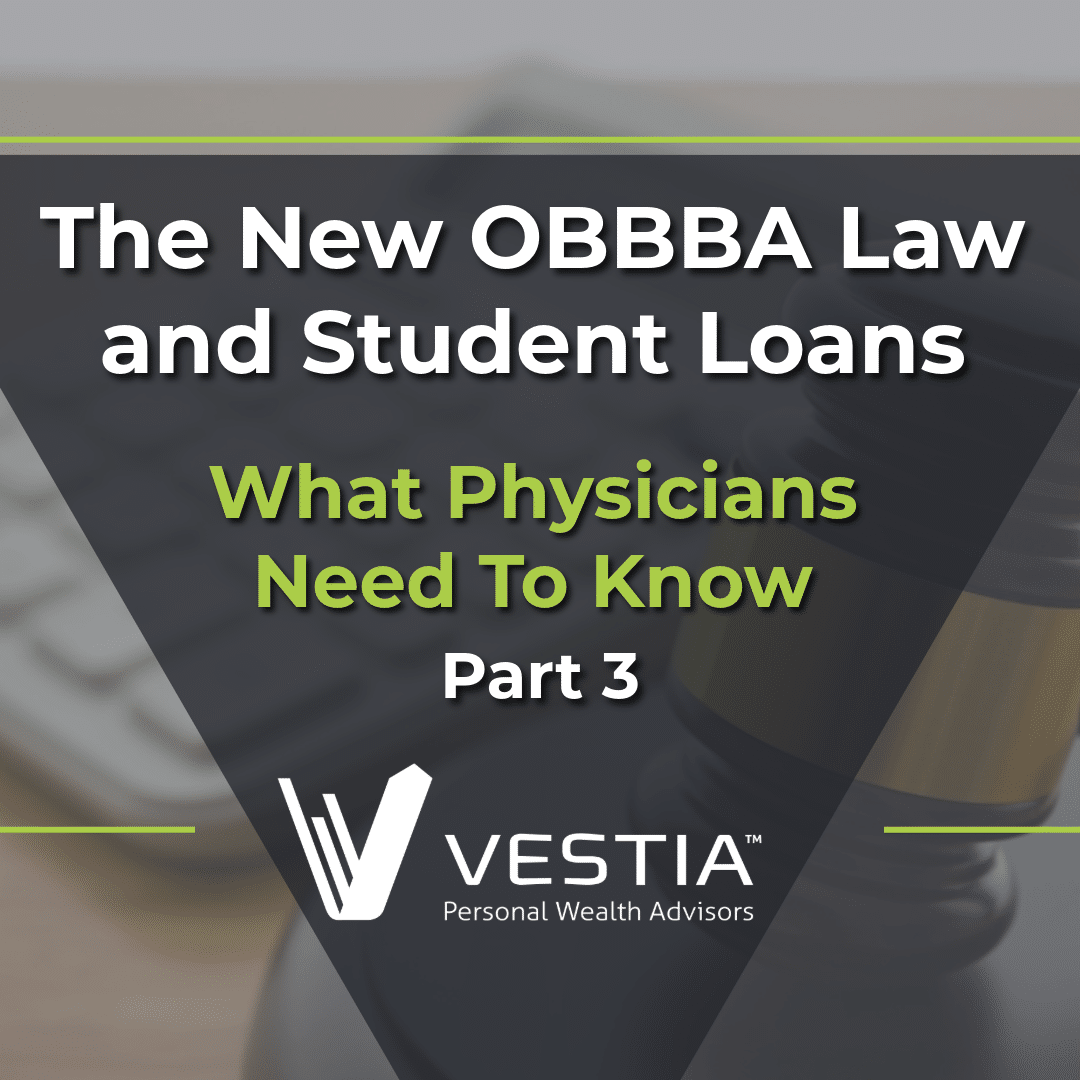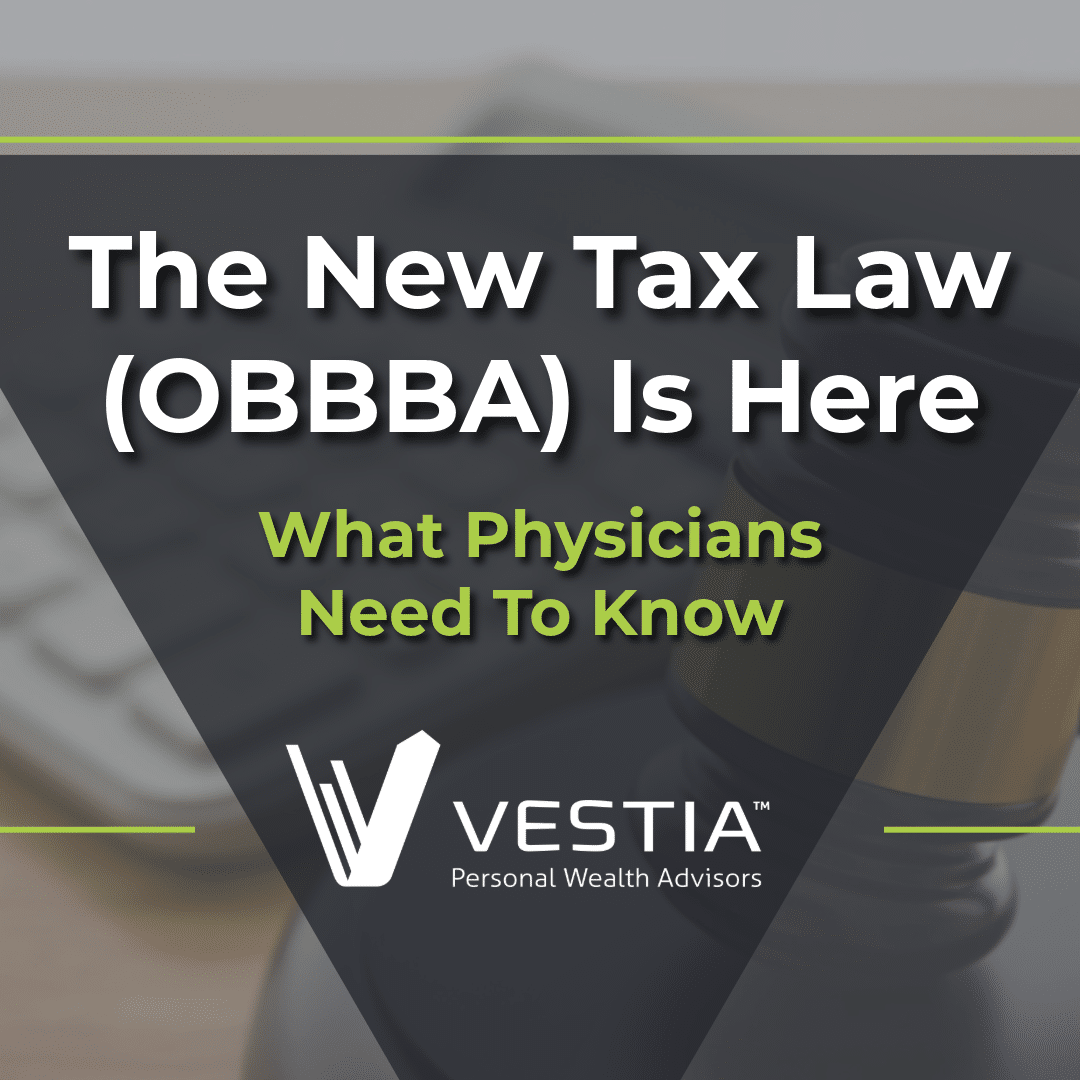The One Big Beautiful Bill for America (OBBBA) was signed into law earlier this month, and because there are so many items to cover, we’re breaking our analysis into a three-part series:
- Part 1: Personal income tax changes that affect physician households [Read here if you missed it]
- Part 2: Changes impacting medical practices and physician-owned businesses [Read here if you missed it]
- Part 3 (this article): Updates to student loans and repayment strategy considerations
In this final part of our series, we’re focusing on what the new law means for student loans, in particular how repayment programs, forgiveness timelines, and tax treatment of forgiven balances may shift for physicians. Given that student loans remain one of the largest financial considerations for many early- and mid-career doctors, these changes could meaningfully alter both short- and long-term repayment strategies.
Now is a great time to review your current repayment strategy to ensure you’re positioned to maximize the financial benefits available under the updated rules while minimizing costly missteps.
Please Note: We are not accountants or student loan servicers. We collaborate closely with trusted CPAs and student loan servicers as needed, but this article is for informational purposes only and not intended to provide tax or legal advice.
Here’s what you need to know about the OBBBA as it applies to federal student loans:
Public Service Loan Forgiveness (PSLF)
PSLF remains intact with many of the same provisions. Residency and fellowship years still count toward credit if you are on a qualifying payment plan, and you must still make 10 years of qualifying payments to receive forgiveness. For most pursuing PSLF, it remains a viable option, although you may end up paying more over the 10-year period due to changes in qualifying repayment plans.
Here are some of the other major changes to be aware of:
SAVE Forbearance Ending
This has been expected for almost a year. If you are currently on the SAVE plan, your loans will start accruing interest beginning August 1st. You will not have a payment due for a few months or until you are moved to another income-driven repayment plan, but these months will not count toward PSLF credit. Work with your advisor to create a strategy that fits your situation.
Repayment Assistance Program (RAP)
This new income-based repayment program is scheduled to start in 2026 and will eventually replace PAYE, SAVE, and ICR payment programs.
Key details:
- Monthly payment = up to 10% of Adjusted Gross Income above $100,000
- If you have dependents, subtract $50 per dependent per month from the payment calculation
- If your monthly payment doesn’t cover the full interest, unpaid interest is waived. This will be helpful for residents and fellows moving forward.
- This plan is PSLF-eligible
We expect more information on its implementation in the coming months.
Modifications to Income-Based Repayment (IBR)
IBR will remain in place going forward, with one major change: you will no longer need to show financial hardship to qualify. Both the original and new IBR plans remain available.
- Original IBR (loans taken out before 7/1/14) – 15% of discretionary income
- New IBR (loans taken out between 7/1/14 and 7/1/26) – 10% of discretionary income
- Discretionary Income = AGI – 150% of the poverty guideline
Maximum Loan Limits
This section of the bill may be the most significant change for student loans, though it only impacts those pursuing new federal loans in the future. Starting Fall 2026, federal loan limits will be:
- Non-Professional Graduate Loans – $20,500 annually; $100,000 aggregate limit
- Professional Graduate Loans – $50,000 annually; $200,000 aggregate limit
- Parent PLUS Loans – $20,000 annually; $65,000 per dependent
This will have a major impact on those entering the medical field. We expect to see more competitive private lending options and potential cost reductions on the professional school side.
Negotiated Rulemaking
Negotiated rulemaking is the process the Department of Education uses to work with representatives from affected groups, such as borrowers, schools, and servicers, to iron out the details of how new laws and programs will be implemented. While the broad strokes of the bill are set, negotiated rulemaking can shape important details like definitions, eligibility requirements, and timelines. This means the fine print could still shift, which is why it’s important to stay informed and work closely with your advisor as the rules take shape. We do not expect the broad strokes laid out above to change.
Understanding how these student loan changes fit into your overall financial picture can help you make intentional, well-timed decisions. With the rest of the year ahead, there’s still time to assess your repayment strategy, explore potential adjustments, and position yourself for the most favorable outcome under the new rules.
We’re here to help both current clients and any of your colleagues who are navigating important student loan decisions. You can reach out directly to your Vestia advisor or CONTACT US if you’d like to be connected with a great physician-focused financial advisor to understand how the above changes impact you and the best path to fit your goals moving forward.


